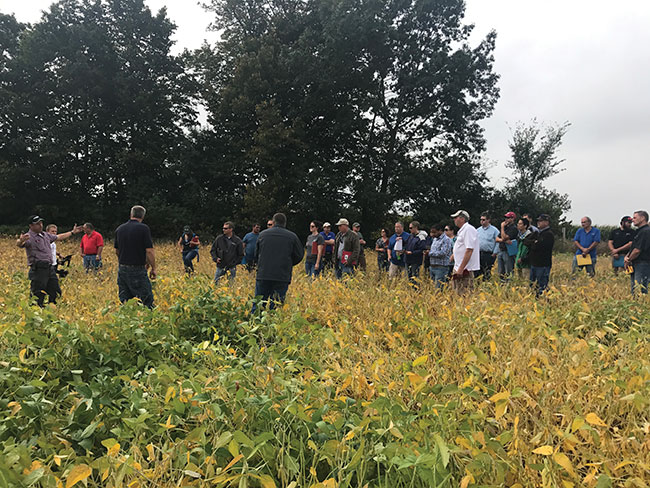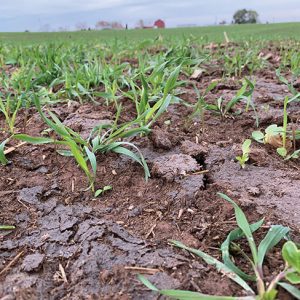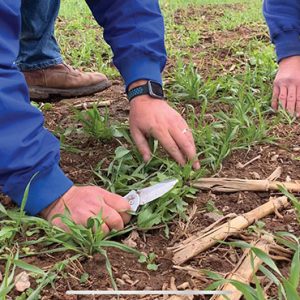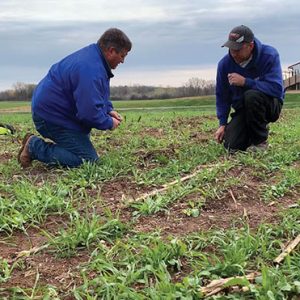
Features
Sustainability
Environment
Making changes and changing minds
A collaborative project to improve water quality in Wisconsin’s Lower Fox River is bringing farmers together to learn from each other.
March 10, 2021 by Alex Barnard
 Dan Brick (left) speaks to a group during a Lower Fox Demonstration Farm Network field day in 2017 at Brickstead Dairy in Greenleaf, WI. Photos courtesy of the University of Wisconsin-Madison Division of Extension.
Dan Brick (left) speaks to a group during a Lower Fox Demonstration Farm Network field day in 2017 at Brickstead Dairy in Greenleaf, WI. Photos courtesy of the University of Wisconsin-Madison Division of Extension. Dan Brick is not afraid to try new things.
Brick currently operates Brickstead Dairy, which has been in his family since 1848. It’s located about 20 miles south of Green Bay in northeastern Wisconsin – close to a lot of water.
Most of the manure produced by Brickstead’s 1,000-head dairy herd is used on their 1,200 acres. The land on which Brickstead Dairy sits is along the Fox River, which leads to Green Bay and eventually into Lake Michigan. So it’s no surprise that water runoff is a concern.
Brickstead doesn’t currently compost or process their manure before applying it. “But that’s definitely something we are working towards,” Brick says. “We keep on getting closer and closer to our goal – to be able to separate those nutrients so we can apply a high nitrogen product for our corn.”
Brick adds that they’d like “to be able to utilize [the manure] through the growing season, or to be able to make it more of an asset, instead of a liability.”
The farm has focused more on water runoff recently. “We’ve got a water collection system for all our leachate water coming off our feed pad area, we’ve built a 3 million-gallon pond to collect all that water,” Brick says of a newer measure installed on the farm. “The goal is to be able to utilize that water for a growing crop or for an irrigation system.
“The nutrients are very minimal in that water,” he adds. “But we’re trying to be compliant with the permit we have from the Wisconsin [Department of Natural Resources], and also turn that into an asset that we can utilize on a growing crop.”
Lower Fox Demonstration Farms Network
Brickstead Dairy is one of the original farms in the Lower Fox Demonstration Farms Network. The project was initiated in 2014 through the Great Lakes Restoration Initiative (GLRI), which is the Network’s primary source of funding. It’s a partnership between the Land and Water Conservation departments of Brown and Outagamie counties, the National Resource Conservation Service (NRCS) and the University of Wisconsin-Madison Division of Extension, in addition to the seven member-farms.
The Network’s main purpose is to confront water quality issues from nutrient runoff in the Lower Fox River, the bay of Green Bay and Lake Michigan. But collaborators have managed to create something more than simply improving water quality.
“[The project started from] this concept of peer-to-peer learning – having farms in the demo farm network serve as a hub for information and how to adopt practices,” says Whitney Prestby, who joined the Network in 2016 as a natural resource educator with the University of Wisconsin Extension.
“Where we are, from a climate standpoint, [we have] cold winters, not a lot of growing days, [and] fall rapidly turns to winter, depending on the year. Up until [the Network started], there weren’t a lot of farms adopting cover crops or no-till practices,” she says, as these conditions and the region’s heavy soil left many farmers believing these practices weren’t practical.
The Network started off modestly, but continues to grow each year. “There were four original farms. They agreed to take 200 acres, work with the agronomist involved in the project, and try to adapt cover crops and no-till on those 200 acres,” Prestby explains.
“We’ve added three more farms here in the Lower Fox – two farms are at 100 percent cover crops and no-till; for the other farms, that’s their goal. Additionally, we have four other demo farm networks in eastern Wisconsin and [are] adding a fifth in there.”
Prestby is excited to see the concept working, but notes they have more work to do. “Obviously, the idea is to not just work with these seven farms or to have the practices contained to just these farms, but rather to see the practices spread throughout the watershed.
“The farms involved in the demo farm network are the ‘early adopters’ in our watershed. They’re the people willing to try these practices and learn from their mistakes.”
As of 2020, the project entered phase two. “Moving into year seven, we’re really focusing on that next level of adopters, those middle adopters: farmers who’ve been attending our events and who have shown interest in trying cover crops and no-till on small acres,” Prestby says.
“The goal is to have these farmers feel like this is worth the investment – whether or not they need to change their equipment or invest in cover crop seed in the fall to make sure they’re covered year-round.”
The Network’s organizers plan to take the lessons they’ve learned through working with the first round of farms and help the next level of adopters and farmers in the watershed. Any farmers interested in joining the Network can follow the Network on Facebook at @FoxDemoFarms to see the concepts put into practice before committing.
“They can come to field days and get to learn from these farms about what’s working, what’s not working, and how they can adapt these practices on their farm,” Prestby says.
She adds that the Network is focused on “setting [new farmers] up for success and working with them.”
Early adopter
Beneficial agricultural practices are something that runs in the Brick family, but over the past 12 to 15 years, Brick says those efforts escalated.
“We were losing a lot of nutrients, we were losing a lot of soil – we needed to do something different,” he says.
When Brickstead began adding more cattle to their herd – but not more land – and growing more forage and corn silage, rather than grain, this led to more manure and more tillage
each year.
“We had to adapt with [those changes], because the things we were doing weren’t working anymore, as far as being able to keep cover on the fields,” Brick says.
Brickstead was initially recruited to the Network because they were already using practices the project wanted to promote.
Brent Petersen, demonstration farm project manager and agronomist with the Brown County Land and Water Conservation Department, happened to drive by Brickstead and recognized cover crops on the fields.
“[The] first time I met [Petersen] was when he pulled in the driveway to talk about the demo farms,” Brick says. “[He] asked if I’d be part of the demo farms, which I didn’t really know at the time what it was going to entail – and I don’t know if anybody really knew what it would entail at that time. But [they were] just trying to get together [farms] to demonstrate what cover crops could do to help hold on to nutrients on the soil.”
“The original plan was to set aside 200 acres of our farm and do some different practices, [like] using cover crops so we could show everybody what cover crops had done,” Brick continues. “Well, we were already using cover crops, and I felt it would be very difficult to just set aside 200 acres. And I thought, ‘If it’s going to work, we’re going to go all in.’ So, we started to convert the farm completely over to a 100 percent cover crop, 100 percent no-till operation.”
The Network has helped with “trying the different practices, but also it’s a way we, as a group, can all collaborate and work through some issues,” Brick says. “Find out what practices did and maybe didn’t work, that we could all learn from it, and [then] we don’t have two or three farms making the same mistake that one already did.”
Challenges
The successes the Network has achieved don’t mean it’s easy to adopt these practices or keep them going.
“The group of farms we have are mainly dairy producers, where we’re dealing with a lot of manure,” Brick says. “Trying to grow cover crops, trying to grow corn silage and also dealing with the manure issue – being able to get the manure on there and get it into a minimal till or no-till system definitely has been the biggest challenge.”
The corn silage Brick prefers to feed his cows takes 106 to 110 days to maturity, which makes the tight window for harvest, manure application and seeding cover crops even tighter.
“We’re taking that silage off, and it’s … a very small window when we can harvest that silage,” Brick says. “So that means, if we got four or five inches of rain two days before that, we have to go in there and get it off. It could be a complete mud mess and a lot of compaction.”
Brick knows that compaction is a big factor in water infiltration and the amount of runoff created, and finds other ways to balance it out in order to “get the water to go down through the soil profile instead of across the field and into the waterways, into the rivers.”
“After we get that silage off to get the manure on there, it could be very, very wet,” he says. “So, another thing that we’re working on is being able to utilize the manure all year-round, so we don’t have a huge amount of manure in the fall to go put on [the fields].”
“But the challenge is getting the equipment that we need to [minimize] disturbance of manure applications, finding out what type of equipment works best before we go out and spend $150,000 on a piece of equipment and then realizing that one doesn’t work,” Brick adds.
This is where being part of the Network can help – the farmers involved can discuss what has or hasn’t worked for them in trying to adopt cover cropping and no-till, including which equipment will do the trick.
“It’s been a slow process – we’re making progress every year with the demo farms,” Brick says. “We’re all learning as we go, and we’re trying to take on these issues and come up with different strategies to be able to make sure that we can do better next time.”
Prestby notes that this attitude is a hallmark of the first farms to join the Network. “They get excited to learn more and [think about] how to do it better next time,” she says.
Incorporating these beneficial practices is not as simple as making the choice to do so, nor is the path forward linear. It’s a balance of sticking with practices that are good in the long-term and what the farm needs each year.
“There’s got to be a lot of planning involved in it,” Brick says. “Even this past year, we had a very wet fall [in 2019], so we did have to do tillage for this year. We can’t sit down and say we’ve been a no-till farm for six or seven years – we’ve practiced no-till, but we end up having to do some tillage here and there to be able to do that.”
“Each farm is definitely different and they have their different goals and what they’re trying to achieve with these practices,” Prestby says. “There are lessons that have been learned that can be generalized from farm to farm, but it really does come down to having motivated farmers and a really great group of partners and agronomists who are willing to sit down with farms and work with them – and their crop consultants and everyone that’s involved in their farms – to think about how to adapt these practices so they fit that individual farm’s needs.”
Looking forward
With the Network entering phase two and looking to add more farms, the project is set to push even farther for beneficial ag practices and improved water quality.
“Our goal is to continuously learn and continue to serve as that learning hub for farmers in the watershed, but with the ultimate goal of getting these practices across all of the acres in northeast Wisconsin,” Prestby says.
She explains it’s an inspiring project of which to be a part. “These practices are mutually beneficial to the environment as well as to the farmer. We’re asking farmers to make some big changes, but they’ve been well-received because [the farmers] are starting to recognize the benefits of improved soil structure and having improved infiltration rates on their fields. And that ultimately is going to help reduce the erosion and reduce the nutrient sediment loss.”
Brick notes that the Network has made major progress beyond what can be physically determined, most notably in changing the mindsets of farmers, equipment dealers and manure applicators about how they operate.
“Some things are hard to measure,” Brick says. “Everybody looks at the water, and [they say], ‘Well, it’s still green.’ But the biggest challenge of anything is changing people’s mindsets, and I think we’ve done that.” •


